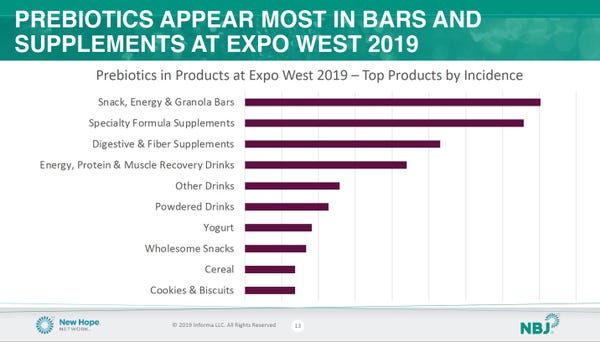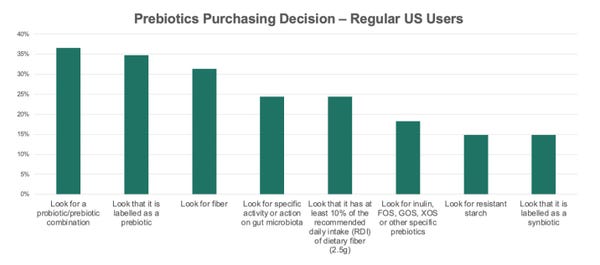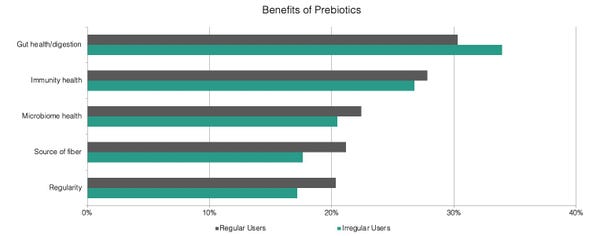Tips for propelling already on the rise prebiotics
The default mechanism-of-action messaging for prebiotics is that they “feed the good” bacteria, which doesn’t tell the whole story.

2020 is going to be a banner year for supplements, and prebiotics are no exception. Awareness of prebiotics has grown to 81%, with 35% of supplement users taking prebiotics at some level, according to Ingredient Transparency Center (ITC) Insights’ 2020 Consumer Survey.
Prebiotics are growing in part based on the foundation laid by probiotics, in addition to an exploding interest in the microbiome in recent years. Digestive health is growing as a functional trend and prebiotics are often appearing as line extensions or simply emerging organically into the market.
The versatility and inherent stability of prebiotic ingredients make them ideal for food and beverage applications. However, while many prebiotic sources are from foods, the foods on their own are not rich enough sources of prebiotics. It can be difficult to consume an efficacious amount of prebiotics from food alone—a key reason for the rise in prebiotic functional foods and beverages alongside growth in supplements. In a 2019 Supply Side West prebiotics workshop presentation, Claire Morton Reynolds, senior industry analyst for Nutrition Business Journal (NBJ), noted prebiotics appeared most often in bars, then supplements, at Natural Products Expo West 2019.

Source: NBJ
What consumers are looking for
Labels are a product’s most valuable real estate. For prebiotics, in the ITC 2020 Consumer Survey, regular users of prebiotics reported that they search for a probiotic/prebiotic (synbiotic) combination, followed by seeing the term “prebiotic” on the label, and then they look for fiber (see chart below). The combination approach makes sense to consumers, even though they don’t recognize the term “synbiotic” as much.

Source: ITC Insights – 2020 Consumer Survey
Benefits evolving
When it comes to consumers identifying prebiotics with potential health benefits, gut health still tops the list. Immune health has seen a steady gain and is now clearly recognized as a benefit.
Regular users of prebiotics are much more likely to recognize multiple benefits such as fiber source (see chart below), but in order to take their full and rightful place in a robust market, it is critical that prebiotics emerge out of the shadow of fiber, as not all fiber is prebiotic and not all prebiotics are fiber.

Source: ITC Insights – 2020 Consumer Survey
Prebiotics are becoming a formulator’s friend because they offer more stability than many probiotics (or a lot of other ingredients, for that matter), and increasingly, have lower dose requirements. Lower dose means less discomfort, which has been a noted obstacle to prebiotic formulas in the past where formulation required multigram quantities. When formulating with prebiotics, it is critical to look at the dose-dependent science to ensure efficacious quantities are provided.
Emerging opportunities
Two key benefit areas offer exciting opportunities in prebiotic product development:
Mood
It is well-established that a bidirectional relationship exists between the brain and the gastrointestinal (GI) tract. A scientific review published in the British Medical Journal, Prevention & Health, concluded that probiotics, either taken alone or combined with prebiotics, might help ease depression symptoms and that further research is warranted (2020;bmjnph-2019-000053).
Inflammation
Inflammation is at the root of many diseases and lifestyle challenges, but the scientific community continues to gain deep insight and understanding of how inflammation works and tools to address it. In a meta-analysis published in The American Journal of Clinical Nutrition, researchers concluded prebiotic and synbiotic supplementation supported systemic anti-inflammatory effects (2017;106[3]:930-945). As the science develops, additional market applications will emerge.
Simple still wins
The prebiotic category is rapidly evolving, with new science revealing potential health benefits and even new ingredients offering prebiotic benefit. This adds excitement to the category, but can also lead to confusion, so it’s critical to keep messages simple.
Sharing a message through the volume and digital noise isn’t easy, especially when that message can be quite complicated. PPC Protect estimates the average person in 2020 is estimated to encounter 6,000 to 10,000 ads every single day. While more consumers than ever before recognize terms like prebiotic and microbiome, these targeted products need to strike consistently through all messaging. It’s difficult at the best of times, let alone when new information is emerging regularly, and attention spans are not so hopelessly fragmented.
The challenge of prebiotics is this: The default mechanism-of-action messaging for prebiotics is that they “feed the good” bacteria, which doesn’t tell the whole story. It is an acceptable place to start, though, as consumers have heard for years about probiotic benefits and mechanisms, and prebiotics are then able to leverage that foundation.
Research and education continue to be key to helping consumers understand this exciting growing category and better tying the actual mechanism—how they work—to the specific benefit area.
Traci Kantowski is the communications director at Trust Transparency Center, a strategy and insights firm serving the natural products industry. She leads the organization’s communications efforts surrounding trust transparency and its single ingredient stewardship programs. Kantowski is a fitness enthusiast and is a certified health coach, certified personal trainer and group fitness instructor.
About the Author
You May Also Like

